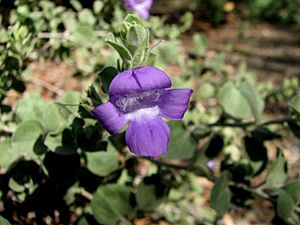Eremophila strongylophylla facts for kids
Quick facts for kids Eremophila strongylophylla |
|
|---|---|
 |
|
| Eremophila strongylophylla in Maranoa Gardens | |
| Scientific classification | |
| Genus: |
Eremophila (plant)
|
| Species: |
strongylophylla
|
| Synonyms | |
|
|
Eremophila strongylophylla is a beautiful flowering plant that belongs to the figwort family. This plant is special because it grows naturally only in Western Australia. It is a small bush with unique round leaves. Its new leaves often have a yellowish color, and its flowers are purple on the outside and white inside.
This plant looks a bit like Eremophila mackinlayi and Eremophila hygrophana. However, you can tell them apart by looking closely at their leaf shapes and the tiny hairs on their leaves and branches.
Contents
Discovering the Eremophila strongylophylla Plant
Eremophila strongylophylla is a round-shaped bush with many branches. It usually grows to be about 0.4 to 0.6 meters (1.3 to 2 feet) tall. Its branches and leaves are covered with a soft layer of fine, yellowish to grey hairs. It also has special glandular hairs, which are like tiny sticky bumps.
The branches feel a bit rough because of the raised spots where the leaves used to be. The leaves are spread out along the branches, not clumped together. Each leaf has a flat stem that is about 1.5 to 5.5 millimeters long. The leaf itself can be egg-shaped, spoon-shaped, or almost perfectly round. They are usually 9 to 18 millimeters long and 6.5 to 13 millimeters wide. The surface of the leaves often looks a bit wavy.
Eremophila strongylophylla Flowers and Fruit
The flowers usually grow one by one where a leaf meets the stem. Each flower sits on a hairy stalk that is about 1 to 3.5 millimeters long. There are 5 narrow, green parts called sepals that protect the flower bud. These sepals are about 8.5 to 11 millimeters long. The outside of the sepals has yellowish hairs, similar to the leaves. The inside has mostly glandular hairs.
The petals of the flower are 18 to 28 millimeters long and are joined together at the bottom to form a tube. The outside of this tube is purple, while the inside is white with purple spots. The outside of the petal tube is hairy. However, the inside of the flower's tips is smooth, and the inside of the tube is full of long, soft, woolly hairs. There are 4 stamens (the parts that make pollen) hidden completely inside the petal tube.
This plant blooms between April and October. After the flowers, oval or cone-shaped fruits appear. These fruits are about 6.5 to 8 millimeters long and are thickly covered with white, branched hairs.
Naming the Eremophila strongylophylla
The plant Eremophila strongylophylla was first officially described by a scientist named Ferdinand von Mueller in 1876. He published his description in a book called Fragmenta phytographiae Australiae.
The second part of its name, strongylophylla, comes from two ancient Greek words. "Strongylos" means "round," and "phyllon" means "leaf." So, the name perfectly describes its special round leaves!
Where Eremophila strongylophylla Grows
This type of eremophila plant is found in areas of Western Australia. You can see it between the Overlander Roadhouse and Carnarvon. It grows in different natural areas like the Carnarvon, Gascoyne, Murchison, and Pilbara regions. It prefers to grow in red, sandy soil, often near rivers or along natural water paths.
Conservation Status
The Western Australian Government's Department of Parks and Wildlife has classified this plant as "not threatened." This means it is not currently in danger of disappearing.
Growing Eremophila strongylophylla in Gardens
Some types of E. strongylophylla are very pretty, especially those with golden tips on their new leaves. All forms are small bushes that produce lovely lilac or purple flowers for a long time.
You can grow new plants from E. strongylophylla by taking cuttings (small pieces of the plant). However, plants grown this way might send out new shoots from their roots, which some gardeners don't like. If you want to avoid this, you can use a method called grafting. This involves joining a piece of E. strongylophylla onto the roots of another plant, like a Myoporum.
This plant can grow well in most types of soil. It likes sunny spots or places with some shade. You only need to water it occasionally if there's a long dry spell. It can handle light frosts, but a very cold frost might damage it. If this happens, you can trim away the damaged parts after winter, and the bush will grow back healthy.
Images for kids


